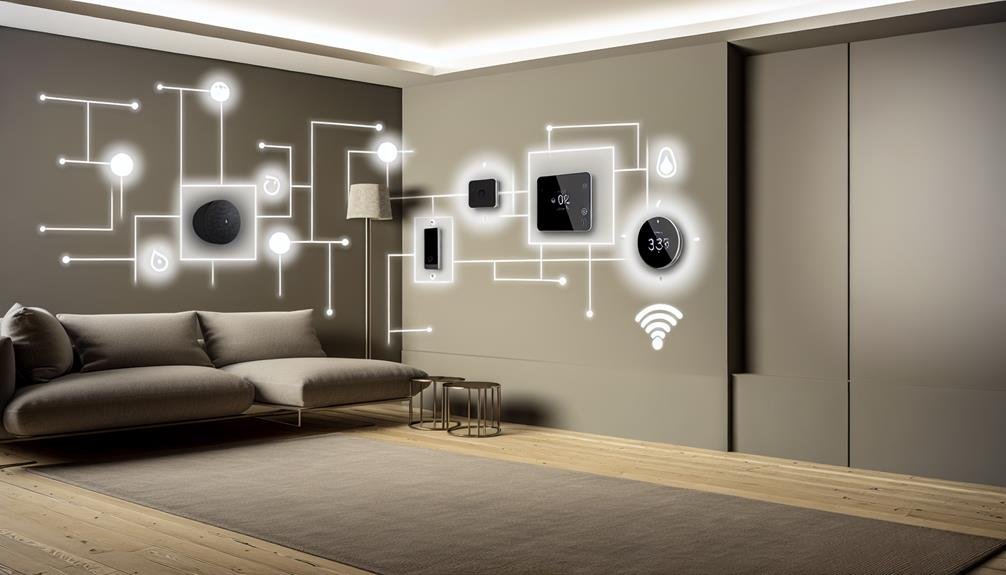Imagine stepping into a smart home automation system that seamlessly orchestrates your daily routines like a well-rehearsed symphony. With a plethora of options available, it can be overwhelming to choose the perfect one.
But fear not, for in this discussion, we will guide you through the essential features to consider when selecting a smart home automation system. From compatibility with your existing devices to ensuring security and privacy, we will leave no stone unturned.
So, sit back, relax, and prepare to embark on a journey towards a smarter, more connected home.
Key Takeaways
- Compatibility and integration are essential considerations when choosing a smart home automation system, including verifying device compatibility and ensuring seamless integration and device interoperability.
- A user-friendly interface and remote access are important features to look for, including voice control and the ability to control devices from anywhere for flexibility and convenience.
- Security and privacy should be prioritized, with robust security features, data encryption, secure authentication methods, and customizable privacy settings.
- Voice assistant integration is a crucial feature, offering hands-free convenience, enhanced accessibility, time-saving efficiency, and seamless integration with other smart devices.
Compatibility With Existing Devices
Ensure that your existing devices are compatible with the smart home automation system by checking their specifications and requirements. Seamless integration and device interoperability are crucial aspects to consider when setting up a smart home automation system.
To achieve a seamless integration, it's essential to verify whether your current devices, such as lights, thermostats, door locks, and security cameras, can connect and communicate with the automation system.
Device interoperability is the ability of different devices to work together smoothly and efficiently. It ensures that all your devices can be controlled and managed from a single centralized platform. Before investing in a smart home automation system, make sure that it supports a wide range of device types and brands. This flexibility allows you to choose the devices that best suit your needs and preferences, without being limited to specific brands or models.
To determine compatibility, check the system's specifications and requirements, specifically the communication protocols it supports. The most common protocols used in smart home automation systems include Wi-Fi, Bluetooth, Zigbee, and Z-Wave. Ensure that your devices are compatible with at least one of these protocols to ensure a smooth connection and operation.
User-Friendly Interface
Setting up a smart home automation system becomes effortless with a user-friendly interface that allows you to easily control and manage your devices. A user-friendly interface is crucial for providing a seamless and intuitive experience, enabling you to take full advantage of the features and capabilities of your smart home system.
One of the key benefits of a user-friendly interface is voice control. With voice control, you can simply speak commands to your smart home system, eliminating the need for manual interaction with buttons or screens. This hands-free control adds a new level of convenience and freedom to your daily routine.
Another important feature of a user-friendly interface is remote access. With remote access, you can control your smart devices from anywhere, using your smartphone or tablet. This means that even when you aren't at home, you can still adjust the temperature, turn off lights, or monitor security cameras. Remote access gives you the flexibility to manage your smart home system on the go, providing you with peace of mind and the ability to stay connected to your home at all times.
Integration With Voice Assistants
With a user-friendly interface that allows for seamless control and management of your devices, the next aspect to explore is the integration of smart home automation systems with voice assistants. Voice assistant compatibility is a crucial feature to consider when choosing a smart home automation system. Here are the benefits of voice control:
- Hands-free convenience: Voice control allows you to control your devices without the need to physically interact with them. Simply speak commands to your voice assistant, and it will carry them out for you.
- Enhanced accessibility: Voice control makes it easier for individuals with physical disabilities or limited mobility to interact with their smart home devices. They can simply use their voice to control lights, adjust the thermostat, or lock doors.
- Time-saving efficiency: With voice control, you can complete tasks quickly and efficiently. Instead of manually adjusting settings on multiple devices, you can issue a single command to your voice assistant, saving you time and effort.
- Seamless integration: Smart home automation systems that are compatible with voice assistants allow for seamless integration with other smart devices. This means you can control not only your lights and thermostat but also your security cameras, door locks, and entertainment systems using voice commands.
Security and Privacy Features
To ensure the security and privacy of your smart home automation system, it's important to implement robust features and protocols. One key aspect to consider is data encryption. This technology ensures that your sensitive information is securely transmitted and stored. By encrypting your data, it becomes unreadable to unauthorized users, providing an additional layer of protection. Look for a smart home automation system that utilizes strong encryption algorithms to safeguard your personal information.
Another important security feature to consider is remote access. This allows you to control and monitor your smart home devices from anywhere in the world using your smartphone or tablet. However, it's crucial to ensure that the remote access feature is secure. Look for a system that offers secure authentication methods, such as two-factor authentication or biometric authentication, to prevent unauthorized access.
In addition to security, privacy is also a significant concern for smart home automation systems. Ensure that the system you choose has built-in privacy features that give you control over the data that's collected and shared. Look for options that allow you to customize privacy settings, such as choosing which devices can collect data and who can access it.
Expandability and Scalability
To ensure the long-term functionality and adaptability of your smart home automation system, it's crucial to consider the expandability and scalability of the technology. By choosing a system with expandability options and scalability benefits, you can future-proof your home automation setup and easily accommodate your changing needs. Here are some key points to understand:
- Flexible device integration: Look for a system that supports a wide range of devices and protocols, allowing you to add new devices and components as needed. This flexibility ensures that your smart home can grow and adapt along with your lifestyle.
- Scalable infrastructure: A scalable system allows you to start small and gradually expand your smart home capabilities. This means you can begin with a few basic automation features and add more advanced functions over time, without the need for a complete overhaul of your system.
- Cloud-based platforms: Opting for a cloud-based smart home automation system offers significant scalability benefits. It allows you to add more devices and users without straining your local network, ensuring a seamless and reliable experience.
- Open standards and interoperability: Choosing a system that adheres to open standards and supports interoperability ensures that your smart home can integrate with a wide range of devices and platforms. This compatibility makes it easier to expand your system and take advantage of new technologies as they emerge.
Considering the expandability and scalability of your smart home automation system is essential for a future-proof and adaptable home. Make sure to choose a system that provides room for growth and can meet your evolving needs.






